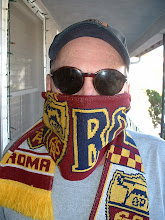

As Pierino likes to point out, honeycomb tripe is the second stomach of "your favorite ruminant." And it tastes good so why not eat more of it? Marcella Hazan had this to say on the subject:
“At one time tripe was so popular that restaurants used to specialize in it, preparing it in a score of different ways. One of reasons it has become such a rare item may be that people no longer know how to prepare it. When you know how to go about it, tripe rewards you with tenderness so succulent, and a fragrance so appetizing, that more expensive cuts of meat cannot match.” ----ESSENTIALS OF CLASSIC ITALIAN COOKING
While Pierino has been off on one of his visits to Purgatory---he seems to like it there. Apparently they have a bootleg satellite set up so he is able catch the Italian football---Pasquino has been doing the cooking. This time it's a Roman classic.
Trippa alla Romana includes a number of favorite Roman flavors: celery (lots), hot pepper, mint, pecorino and parmigiano, and of course "trippa."
Because it's Roma there is plenty to argue about. But the basic recipe goes like this: take one to two pounds of honeycomb tripe, rinse it off and cut it into strips about 3" long. Cover it in cold water and simmer for about 2 hours. Meanwhile saute some chopped onion, some whole cloves of garlic lightly smacked, and some chopped celery in olive oil. Have that ready for when your tripe has finished its initial cooking.
To your soffrito of onion, celery etc add one or two dried red peppers or hot chili flakes to your liking. Add the drained trippa and raise the heat to medium. Add one cup of tomato sauce along with any leftover celery leaves. Partially cover and cook until tender. Grate equal amounts of pecorino romano and parmigiano cheese into a bowl. To the cheeses now add a lot of chopped mint and mix thoroughly.
Serve your tripe in bowls and finish each portion with a generous amount of cheese and mint.
Pasquino purchased 1 pound of tripe for about $3.00. And Roma beat Palermo 1-2 upon the return of Totti to the starting team.
---Pasquino





